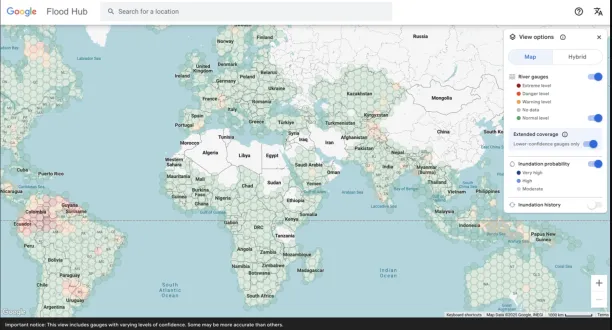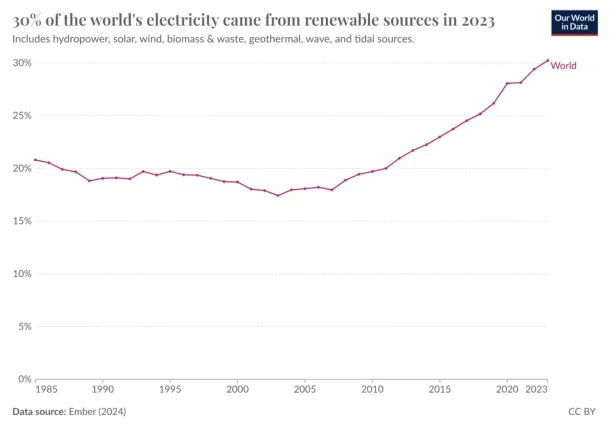According to PwC, GenAI could improve operational efficiency, which might indirectly reduce carbon footprints in business processes.1
Companies can implement strategies to reduce energy consumption during the development, customization, and inferencing stages of AI models. By leveraging GenAI applications, companies can offset emissions in other areas of their operations.
Discover sustainability AI applications with real-life examples that leverage AI for a smarter, more efficient, and sustainable future.
1. Preparedness for natural disasters
AI plays a crucial role in improving disaster preparedness and response, especially as extreme weather events become more frequent and intense due to climate change. By powering systems like flood warning networks and forest fire detection, AI helps save lives, protect livelihoods, and minimize economic losses.
Using real-time data, predictive models, and advanced sensors, these technologies provide early warnings and actionable insights, giving us a better chance to reduce the devastating effects of natural disasters.
Real-life example:
Google has introduced Google Earth AI, a suite of geospatial AI models and datasets designed to manage global challenges like weather prediction, flood forecasting, and wildfire detection.
Part of this launch includes AlphaEarth Foundations. These models support urban planning and public health by analyzing imagery and population data, and they already power features in Google Search, Maps, Earth, and Cloud.
The goal is to provide actionable insights to help solve critical environmental and societal issues.2
AlphaEarth Foundations is an artificial intelligence model designed to integrate extensive Earth observation data into coherent digital representations of terrestrial land and coastal waters.
By processing petabytes of satellite imagery and geospatial measurements, the model enables more accurate and efficient environmental monitoring and analysis. Its outputs, referred to as embeddings, are now available through the Satellite Embedding dataset on Google Earth Engine.
These embeddings have already supported over 50 organizations, including the United Nations and academic institutions, in efforts such as ecosystem classification, agricultural assessment, and land use monitoring.
AlphaEarth Foundations also demonstrates significant improvements in data compression and mapping accuracy, and can serve as a foundation for future integration with general-purpose AI systems.3
Flood warning
According to recent data, 250 million people are affected by flooding yearly. PwC suggests that AI-driven improvements in flood warning systems could save more than 3,000 lives and reduce economic damages by up to $14 million. These technologies provide timely alerts, helping communities take action before disaster strikes.4
Real-life example: Google’s operational flood‑forecasting system, based on a large LSTM-based language model for hydrology, was launched in 2018. It combines two AI models: a hydrologic stage‑forecasting LSTM that predicts river levels, and an inundation model (using threshold and “manifold” algorithms) that simulates the flood extent and depth to generate alerts up to seven days in advance.5
The system currently covers over 100 countries via “virtual gauges” and verified river basins, reaching approximately 700 million people with flood-forecasting alerts delivered through Google Search, Maps, Android, the Flood Hub, and government partners.6
Key achievements include:
- Flood forecasting via LSTM stage and inundation models.
- Mature deployment since 2018 in over 100 countries.
- Up to 7-day lead time with real‑time alerts to 700 million people.
- Strong evidence through Nature/HESS publications.

Figure 1: The image illustrates Flood Hub’s global reach, showing how it supports flood forecasting for more than 700 million people.
Forest fires
AI is also a powerful tool in the fight against forest fires, helping to prevent devastating losses. Drones, satellites, and sensors on tall towers continuously monitor forests, detecting signs that could indicate the start of a fire, such as unusual hot spots or rising smoke.
With proper training, AI can learn to differentiate between smoke and other forest scents, providing more accurate early warnings and quicker responses to potential fires..
Real-life example: Dryad Networks has installed around 400 “electronic noses” in the Eberswalde forest in Brandenburg, a region heavily affected by wildfires. These devices can detect gases during the earliest stages of a fire while also monitoring temperature, humidity, and air pressure.
By providing real-time data on environmental conditions, these sensors help identify potential fire risks early on, improving the ability to respond quickly and minimize damage..7
2. Fighting air pollution
Air pollution is getting worse, and it can escalate to a global public health and environmental emergency that causes over seven million premature deaths every year and $8.1 trillion in health damages alone.8
AI can help reduce air pollution with real-time warnings and predictive models:
Real-time warnings
With data provided from air quality monitors, AI can offer insights on the impact of air quality on people and help decide on health protection policies.9
Also, by processing data from different monitors in real time, it can send out alerts when pollution levels spike. This way, people can act right away: stay in or wear masks.
Real-life example: IQAir application has a ranking that shows in real time which towns have the most pollution in the air. The Plume Labs app gives full maps that show where pollution is worst. The app also tells what the air quality will be like every hour, as levels can change significantly during the day.10
Predictive models
Developed with AI and machine learning models, predictive models can forecast information such as air-pollutant concentration.
Real-life example: Engineers from Cornell designed a model that can calculate the fine particulate matter (PM2.5), which is the soot, dust, and exhaust from trucks and cars that gets into people’s lungs. Using these models, future negative impacts can be avoided.11
3. Biodiversity monitoring
Conserving biodiversity is one of the biggest challenges brought by climate change. AI offers solutions for improving biodiversity monitoring and conservation.
Technologies such as neural networks, computer vision, and satellite vision can help researchers detect animals in images and identify specific animals within a species. Researchers can monitor animals such as birds, amphibians, cetaceans, and even fish and analyze the data through machine-learning tools.12
With these technologies, scientists can make:
- Better habitat analysis.
- More precise guesses on wildlife and species.
- Analyze climate change’s impact on animals in real-time.
Real-life example: Wildbook uses neural networks and computer vision algorithms to find and count animals in pictures and to identify individual animals within a group. With this knowledge, wildlife population sizes can be estimated more accurately.13
4. Data analysis for sustainability
Large language models (LLMs) like GPTs are crucial in driving a more sustainable future by assisting organizations in analyzing and taking action based on large datasets. Some key applications of AI in this domain include:
Analyzing business documents & reducing waste
Generative AI systems can review and analyze business documents, helping companies spot opportunities to cut waste and improve their sustainability efforts. For example:
- Generative AI tools can analyze data on transportation, energy use, and other resource consumption to provide accurate carbon footprint calculations at a lower cost.
- AI algorithms can optimize supply chain processes by identifying inefficiencies and suggesting ways to cut fuel consumption. These technologies help reduce greenhouse gas emissions and minimize resource use.
- By leveraging AI, companies can gain valuable insights into their energy consumption, helping them shift to renewable energy sources and improve overall energy efficiency.
This integration of AI technologies allows businesses to reduce their environmental impact while embedding sustainability into their operations.
Identifying scope three risks
Detecting Scope 3 greenhouse gas emissions, those generated indirectly through supply chains and product lifecycles, can be challenging. However, by using AI tools like ChatGPT, companies can effectively identify these risks by analyzing large volumes of publicly available data, such as:
- News articles, industry reports, and social media posts that highlight environmental challenges related to suppliers or production processes.
- Emerging environmental sustainability risks that might impact sustainability strategies.
Businesses can proactively address climate change concerns and align with environmental justice principles by identifying these risks.
AI for energy and resource optimization
AI systems, including those deployed by cloud service providers, can help businesses and organizations:
- Optimize energy usage in data centers through better cooling systems, improving power usage effectiveness (PUE).
- Predict and manage energy storage needs, aligning renewable energy generation with demand.
- Reduce electronic waste by extending the entire lifecycle of devices using AI-driven maintenance recommendations.
Real-life example: NVIDIA’s Earth‑2 is a GPU‑accelerated climate‑simulation platform enabling kilometre‑scale global modelling.
It launched a generative‑AI model called cBottle (“Climate in a Bottle”) in June 2025. The model can generate global atmospheric states conditioned on inputs like time of day and sea‑surface temperatures, with resolution down to 1‑2 km and significantly reduced computation time and energy use.14
This system achieves:
- Data compression ratios up to 3,000× per sample.
- Forecast speeds thousands of times faster and up to 10,000× more energy‑efficient than traditional methods.
- Integration of AI‑based downscaling (CorrDiff) to provide super‑resolution weather insights.
- Active adoption by leading research institutions (MPI‑M, AI², Alan Turing Institute) facilitates interactive digital‑twin climate exploration.
Key features include:
- Kilometre‑scale climate simulation and interactive visualisation.
- Generative AI (cBottle + CorrDiff) for rapid, high‑resolution forecasts.
- Proven by real‑world testing (GTC, hackathons) and institutional collaboration.
5. Sustainable agriculture
AI technologies in agriculture are helping farmers manage challenges like resource inefficiency and environmental impact. By incorporating tools such as agricultural robotics, weather monitoring systems, and land management algorithms, farmers can optimize their operations, reduce waste, and meet sustainability goals.
Additionally, AI-powered crop and animal monitoring ensures healthier yields and livestock by detecting issues early, reducing the need for chemicals, and minimizing resource usage.
Agricultural robotics
Similar to a self-driving car, AI-powered robots can move around and harvest crops when they’re ready and mature enough. This helps reduce waste and can improve production lines.
Weather monitoring
AI can also monitor and forecast the weather. This helps farmers predict the weather in a specific location, giving them insights on when to water their crops or when it’s the best time to plant or harvest.
Land management
Another use case of AI is farmland planning. Using satellite images, algorithms, and land-use data, farmers can plan where and when to plant their crops. This can also help them ensure regulatory compliance.
Crop and animal monitoring
AI can help farmers keep their crops and animals healthy. With image recognition and sensors to spot crop conditions, AI can help reduce bugs attacking crops or early signs of animal diseases.
Farmers can then step in and fix the problem without using excessive amounts of chemicals or medicines, reducing potential losses.
6. Less defective production
AI-enabled computer vision systems can address product return issues stemming from defects or customer dissatisfaction by minimizing production errors at the manufacturing stage.
Computer vision-enabled quality control systems installed on the conveyor belt or production line can inspect the quality of the product more accurately and efficiently than manual inspection.
See how it works:
This reduction in defective products can ultimately reduce the organization’s product returns and GHG emissions related to reverse logistics and other return processes.
7. Better leak detection in production
Computer vision systems can help detect water leaks and other harmful chemicals within a production plant and alert authorities to take quick action. This can help businesses reduce their environmental impact.
See how it works:
8. Safer workplace
Sustainability consists of three parts: environmental, social, and governmental. To be truly sustainable, a business needs to focus on all three.
AI-enabled computer vision systems can help improve worker safety by ensuring compliance with safety rules. This can help improve a business’s social sustainability by making the business more secure for its workers.
Smart cameras can be installed at certain points of the manufacturing facility to inspect if the workers are following the rules and wearing safety equipment. The system can also identify other risks in the facility and notify the relevant operations or safety manager for further action.
9. Reduced energy consumption

Figure 2: Global share of electricity from renewable resources.
Even though investments in renewable energy have increased significantly in the past few years, renewable energy accounts for only 30% of the world’s electricity generation.15
AI can help increase use of renewable energy by studying the patterns of energy consumption and providing insights on reducing and improving consumption while not compromising the company’s productivity.
10. Optimized and sustainable logistics
AI can also help improve the sustainability of the distribution and logistics operations of a business, which account for a significant chunk of the total corporate carbon footprint.
AI-powered software can provide optimized routes for product delivery by incorporating sustainability as a key factor. Route optimization systems have become a necessity for logistics firms since they provide significant financial and environmental benefits.
Watch how AI and digital twin technologies are helping with sustainable last-mile delivery:
Check out logistics AI use cases to learn more about how AI is revolutionizing the logistics sector.
What are the challenges of sustainability AI?
Artificial intelligence looks promising in helping protect the environment, but it also presents some challenges:
Computing energy
Advanced AI models need significant computing power, which means they use a lot of energy.16
This influences both operational prices and carbon emissions. Thus, using energy-intensive AI technologies in the service of environmental sustainability can be paradoxical.
Labor abuses
Large language models such as ChatGPT can require labels to keep the model away from toxic texts. To get these labels, OpenAI sent tens of thousands of particle texts to a firm in Kenya. The data labelers employed by the company are paid only around $1.32 and $2 per hour.17
This raises questions about whether workers’ rights are being usurped in developing AI tools for a sustainable future.
AI bias and ethics
AI models learn from data, and if the data is biased or represents only a particular part of reality, the models can produce incorrect results. For instance, an AI model trained in location-specific data can fail to generate data for other areas.
Decisions based on AI results can greatly affect society and the world. Therefore, questions can arise about data privacy and ownership.
Best practices to mitigate challenges
Energy efficient AI
The priority should be using algorithms and devices that use less energy. Research groups can work on designing models that balance how well AI works and how much energy it uses.18
AI computing infrastructure can be powered by renewable energy sources, which can help lower the carbon footprint even more.
Addressing AI bias
AI models should use appropriate methods for collecting, testing, and validating data to avoid bias. Including representative data and considering how conditions can vary in different locations are also important.
Developing ethical guidelines
For AI to protect the environment, ethical guidelines and policies must be designed and followed. This includes clear rules about who owns the data, how to keep it private, and how to use AI ethically.
Encouraging stakeholder engagement
Involve stakeholders in the decision-making process, specifically the groups that will be affected by AI’s results. This means ensuring everyone knows how AI models work and what data they use.
External Links
- 1. Impacts of generative AI on sustainability: PwC .
- 2. Google announces state-of-the-art geospatial AI models with Earth AI. Google
- 3. AlphaEarth Foundations helps map our planet in unprecedented detail - Google DeepMind.
- 4. https://www.pwc.co.uk/sustainability-climate-change/assets/pdf/how-ai-can-enable-a-sustainable-future.pdf
- 5. https://arxiv.org/pdf/2111.02780
- 6. Flood Forecasting - Flood Forecasting.
- 7. These electronic ‘noses’ can sniff out wildfires and alert fire authorities using AI | Euronews. euronews
- 8. https://uploads-ssl.webflow.com/5a25e6430f93020001836dfa/63737b7254fad4b301c5ad89_GHV_CAF_AQM%20Report_FINAL.pdf
- 9. How artificial intelligence is helping tackle environmental challenges. United Nations Environment Programme
- 10. AirNow and Other Apps to Help You Track Air Quality Near You - The New York Times. The New York Times
- 11. Frontiers | Applications of artificial intelligence in the field of air pollution: A bibliometric analysis. Frontiers
- 12. AI empowers conservation biology. Nature Publishing Group UK
- 13. https://lynx.wildbook.org/
- 14. New NVIDIA Earth-2 Generative AI Foundation Model Simulates Global Climate at Kilometer-Scale Resolution | NVIDIA Blog.
- 15. 30% of the world's electricity came from renewable sources in 2023 - Our World in Data.
- 16. As the AI industry booms, what toll will it take on the environment? | Artificial intelligence (AI) | The Guardian. The Guardian
- 17. OpenAI Used Kenyan Workers on Less Than $2 Per Hour: Exclusive | TIME. Time
- 18. New hardware offers faster computation for artificial intelligence, with much less energy | MIT News | Massachusetts Institute of Technology.



Comments
Your email address will not be published. All fields are required.